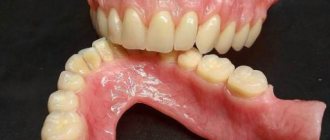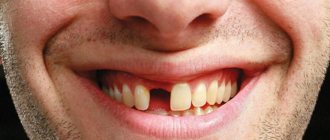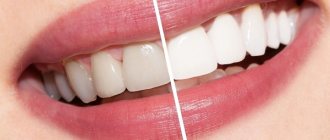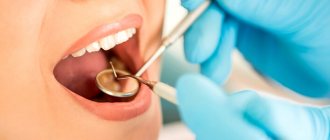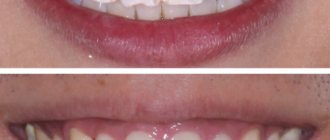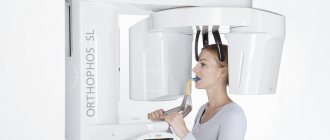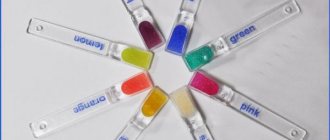Polyodontia (hyperodontia, hyperdentia) is the appearance of supernumerary teeth. Normally, an adult has 28-32 teeth (including wisdom teeth); with polyodontia, an indefinite number of extra teeth appear. About 2% of the world's population suffers from the pathology.
There are no methods to prevent the development of polyodontia, but it is possible to reduce the number of complications caused by the disease. Therefore, it is necessary to be attentive to your health and undergo a preventive examination with a dentist twice a year. If you suspect that an extra tooth has appeared in your mouth, you should immediately consult a doctor. Particular responsibility lies with parents, since children are not able to independently monitor the health of their teeth.
Concept and signs of supernumerary teeth
Hyperdentia (hyperdentia from hyper and lat. dens, dentis tooth) is an anomaly in the number of teeth.
Up to a certain age, children should ideally have twenty milk teeth, which are gradually replaced by permanent ones, and there are 32 of them. With hyperdontia, these numbers shift by one or more positions in a larger direction, since in this case there are one or several more tooth buds than normal.
Supernumerary teeth, as a rule, erupt after the main teeth, but there are exceptions when the supernumerary has erupted and taken the place where a normal tooth should be. As a result, teeth shift and bite changes. Only in rare cases does hyperdontia make itself felt during the period of milk eruption. Most often, this anomaly occurs among men, which accounts for about 65% of the total number of such cases.
In 15% of cases of this anomalous phenomenon, more than two supernumerary teeth erupt on the gum or palate. The most common phenomenon among hyperdontic anomalies is the eruption of supernumerary teeth in the area of the lateral incisors on the upper jaw, and less often on the lower jaw. Such teeth may differ from normal ones in shape, structure, color, which indicates their abnormal origin.
Types of hyperdontia
There are several of them. And they differ in the degree of inconvenience for their wearer and in the possible consequences. And even according to the subjective feelings of people who have been diagnosed with this disease.
Typical hyperdontia
This pathology is characterized by the presence of extra teeth that began to grow without leaving the dentition in the mouth. Since two normal-sized teeth would be cramped, such teeth, called twins, are reduced in size. This is expressed in the reduction of their coronal part.
The cause of this anomaly is most often heredity.
Atypical or atypical
This pathology with an increase in the number of teeth is characterized by the growth of extra teeth outside the dentition. Usually on the palate, where they can take up almost all the available space. Or the lateral surfaces of the jaw arches, most often from the side of the tongue. It is a very rare form of pathology.
Real (true)
Supernumerary permanent teeth in this type of hyperdontia appear from the formation of excess root buds or when the roots split in the initial stage of their growth. It does not cause significant inconvenience as long as both teeth in a pair of “twins” are healthy. Problems arise if at least one is affected by caries, the treatment of which can be difficult due to the intertwining of the roots of such teeth. For the same reason, there are difficulties with their removal.
False hyperdontia
Probably the most harmless of all, from the “it will go away on its own” series. Although, of course, medical supervision is mandatory in order to avoid developmental complications. It occurs when a child’s bite changes due to the replacement of milk teeth with permanent ones. It occurs when a permanent tooth erupts, when the milk tooth has not yet fallen out. Corrected after the loss or removal of a baby tooth. The decision to remove is made by the doctor.
The long-term coexistence of missing baby teeth and new, permanent ones is not such a rare phenomenon. This happens due to the inattention or even frivolity of parents who missed such an important stage in the development of the child. Especially if the growth of permanent teeth occurs painlessly.
Hyperdontia in an adult
In adults, hyperdontia is much more common than in children. Additional teeth are mainly located in the palate or on the gums, which is unnatural and contrary to the norm. The eruption of an “extra” tooth can cause the following symptoms:
- Impaired diction. The person begins to burr and vaguely pronounce some sounds and sound combinations.
- A feeling of discomfort caused by the abnormal position of supernumerary teeth. Such teeth provoke curvature of the dentition.
- Malocclusion. This problem entails a number of dental diseases, such as pathological tooth wear, impaired diction and others.
- Damage to the oral mucosa with subsequent inflammation;
- Impaired chewing function, which leads to gastrointestinal problems.
This type of anomaly often causes nervous breakdowns and mental disorders. Due to the displacement of the dentition, healthy teeth lose their strength and begin to loosen under the pressure of the growing supernumerary rudiment. The jawbone swells, which leads to pain. Constant aching pain leads to irritability, apathy and deterioration in general well-being.
What does it look like
The main symptom or sign is the presence of extra teeth or even a hint of their appearance in the form of a painful swelling in the mouth. In such cases, the first thing they do is targeted radiography, which allows one to clearly diagnose problems in the area of 4-5 teeth.
If this method turns out to be ineffective, an orthopantogram is used, which reflects a more complete picture of the condition of the roots of the teeth and jaw bones. And to obtain a 3D picture of the condition of the roots and crowns, you can make a computer tomogram.
This anomaly can appear at any age. True, in adults and children the clinical picture of the development of the disease can manifest itself differently.
In children
Extra teeth can come out in the first few months of a child’s life, that is, in full accordance with the timing. But their number will be doubled. Although there have been cases of the appearance of such teeth immediately after the birth of the baby, in the first weeks and even days of its existence.
Both the baby and the mother suffer from such a “toothy” because:
- When teeth grab the nipple, wounds and cracks appear on it.
- In a child, the unpleasant sensations from teething intensify many times over.
- Poor milk flow due to improper latching of the breast.
- The child has difficulty sucking milk.
Manifestations of hyperdontia in an infant can be expressed in:
- Poor nasal breathing due to swelling of the nasal mucosa.
- Severe drooling.
- The gum tissue is swollen and painfully red.
- The temperature rises to low-grade levels, that is, up to 38⁰C, for several days.
If the case is advanced, then the symptoms change to the following signs:
- diction is impaired;
- an incorrect bite is formed;
- due to injury to the mucous membrane of the tongue and the inner surface of the cheek, wounds regularly form on them;
- there is no complete closure of the main dentition.
All this will be especially pronounced if extra teeth begin to grow in the area of the upper palate. Hyperdontia especially hinders children who have begun to develop speech. The first consequence of the appearance of extra teeth will be a lisp due to the fundamental impossibility of pronouncing sounds correctly. After all, teeth that have grown outside the dentition will not allow the tongue to take the correct position when trying to pronounce hissing, voiceless, and voiced consonants. No speech therapist can help solve this problem.
And the presence of extra teeth at primary school age (especially if they immediately catch the eye during a conversation) can serve as a subject of ridicule and even bullying from peers. Which is also fraught with deep psychological problems.
In adults
Abnormal dental development in adults may have the same symptoms as in children. But because the tissues of the oral cavity have already been formed and have essentially stopped in their growth and development, additional symptoms may include:
Dystopian teeth
That is, additional teeth whose growth has stopped and the bite has already been formed. And there is no longer room for the growth of other teeth.
- The growth of extra teeth occurs in the roof of the mouth or in the lingual (tongue-facing) part of the gum. Moreover, in the upper jaw - in the lower jaw, cases of germination of extra teeth are recorded much less frequently.
- The teeth have an incorrect turn, an atypical angle of inclination, and are curved.
- The teeth adjacent to the abnormal swelling become loose.
- In the area of tooth growth, protrusion of the jaw bone is observed.
- The gums often become inflamed, and X-ray examination at the initial stages of the anomaly reveals deformations of the jaw bones - even before the roots of extra teeth form.
In adults, dystopic teeth become a source of psychological problems. Such people are often withdrawn and unsociable. And psychological problems then turn into chronic forms of diseases of the digestive, nervous and endocrine systems.
Impacted teeth
This term refers to teeth that are unable to erupt and remain in the bone tissue of the jaw. A person often does not even suspect their presence until they make themselves felt with all sorts of complications. Namely:
- Loosening of normal, healthy-looking teeth.
- When an impacted tooth is located close to the edge of the jaw, a subcutaneous or axillary protrusion appears on the face.
- At any time of the day, aching pains can appear and just as suddenly disappear.
The most difficult moment is the appearance of supernumerary teeth in place of impacted third molars, or “wisdom teeth.” Which cannot germinate due to the presence of supernumeraries. Because third molars have a large area of chewing surfaces, such attempts to erupt lead to overstraining of the gum tissue and even entangling of the roots of other teeth during the growth process. The consequences of this can manifest themselves in the form of inflammation of the roots of all molars up to and including the premolar.
Hyperdontia in children
Sometimes the eruption of extra abnormal teeth in children is almost asymptomatic. The only sign of polyodontia is the number of teeth erupted, which exceeds a certain norm for a particular age. Most often, this anomaly is accompanied by a number of unpleasant symptoms, which should cause concern among parents and become a reason to consult a dentist.
Signs of polyodontia in children:
- a rapid increase in temperature, which is difficult to bring down and lasts from one to several days;
- a strong aching or throbbing pain is felt at the site where the irregular tooth erupts;
- there is a feeling of discomfort when talking, eating, drinking;
- a slight swelling of the cheek and even the wing of the nose is noticeable on the side where the extra element erupts;
- due to excessive salivation as a reaction to an irritating factor, a wet cough and difficulty breathing may occur;
- gastrointestinal disorder as another reaction of the body to the inflammatory process and high temperature.
The symptoms of the eruption of supernumerary teeth in children are similar to those observed when the first milk teeth appear, only in this case the situation is a little complicated by the fact that the germination of an extra tooth is not something normal and inherent in nature. This makes it more difficult for the child to tolerate this phenomenon than the eruption of healthy baby teeth.
Treatment of hyperdontia
It happens that there is no need to treat such an anomaly at all: if the teeth do not extend beyond the dentition, do not disturb their shape and do not injure the mucous membrane. In other cases, the presence of supernumerary teeth in the mouth requires serious intervention. Usually a dental surgeon.
It can not only remove unnecessary teeth that clearly interfere with normal life, but also help the necessary teeth to emerge. And the orthodontist will help correct the bite.
Extra teeth must be removed if:
- Milk teeth do not allow permanent teeth to erupt normally, and a growing person retains a “milk bite.”
- In the dental arch, the teeth are positioned incorrectly, grown with displacement and a strong inclination. This phenomenon is called dystopia.
- The crown is stuck in the gum or bone and cannot erupt. This is called retention.
Such pathological cases in dentistry can be treated without difficulty. If, of course, the patient turned to the appropriate doctor on time. Although there are nuances associated with each specific person.
The question of removing extra teeth is decided by the doctor based on: the stage of formation of the dental system, the inclination of the supernumerary tooth, what consequences and defects are predicted from a particular situation.
Sometimes, if supernumerary teeth:
- interfere with normal eruption;
- contribute to the formation of three – abnormal gaps between the teeth, causing caries in the gum pockets, and diastema – an extra-wide interdental space;
- impacted ones are not capable of eruption due to the fact that they are incorrectly formed and strongly inclined;
- may cause bite defects.
Causes of jaw abnormalities
To date, doctors have not reached a unanimous opinion about the causes of such an anomaly as hyperdontia. There are different hypotheses about this:
- Atavism. Historians have proven that primitive people, due to the way of life they led, naturally had 36 tooth primordia. The results of studies of the remains of those times indicate that people had six incisors on the upper and lower jaws. Therefore, polyodontia is a kind of genetic anomaly that makes itself felt after thousands of years;
- Many doctors are inclined to the theory that one embryo splits into several in the womb, when, in fact, they begin to form. This theory also states that an anomaly can develop throughout pregnancy if it was quite severe, the woman suffered serious illnesses or led an unhealthy lifestyle (bad habits, drugs, alcohol and others);
To date, research continues to establish the true cause of hyperdontia. Based on these data, modern doctors are more inclined to the second version than to the first.
Causes of hyperdontia
Experts do not have a unified theory for the occurrence of this abnormal dental condition. There are 4 recognized versions of the causes of hyperdontia, each of which has the right to exist:
- Embryonic splitting of the root germ of the tooth. It can only be considered as a version if a single, or at most double, splitting occurred. This means that the failure to duplicate the roots of the teeth occurred in the womb, before childbirth, and was caused by some illness during this period.
- Formation of tooth germs beyond the set provided by nature. The reason is the same as in the theory of embryonic splitting during the prenatal period of development. Only the mother had to suffer a very serious illness with treatment with potent drugs. Or in the area of her residence, a critically unfavorable environmental situation is observed from year to year.
- Heredity factor. If the parents had hyperdontia, the risk of its manifestation in the child increases by 2-3 times.
- Manifestation of atavism. Our distant primitive ancestors had not 4, but 6 incisors in each jaw in their mouths. Proponents of the theory of atavism believe that this is an attempt by nature to return the body to its original version of development. True, the atavistic theory cannot explain the appearance of extra molars.
Judging by the statistics collected on hyperdontia, the theory of environmental pollution has the greatest chances. Which, however, is quite consistent with the 2nd and 3rd hypotheses. This is supported by the fact that now the frequency of such developmental disorders has increased, and on a global scale, cases of hyperdontia account for up to 2% of the total number of inhabitants. A huge number if you think about and remember the total number of inhabitants of the Earth.
Types of hyperdontia
Depending on the location of the supernumerary teeth, several types of polyodontia are distinguished:
- Conical or awl-shaped tooth . In this case, excess rudiments erupt between the upper central and lateral incisors. The name of the anomaly comes from the peculiar shape of the supernumerary tooth, which looks like an awl. This form of hyperdontia is dangerous because the sharp end of the tooth often injures the mucous membrane, which is why an inflammatory process develops when an infection gets there.
- Additional molars . Such teeth grow between the main molars, displacing the dentition from the correct position.
- Extra fangs . This type of anomaly is typical for the upper jaw.
- Supernumerary premolars . These additional teeth are located on the lower jaw. Each type of anomaly looks different depending on where and how the extra teeth are located. These differences can be clearly seen in the photo.
Types of polyodontia disease
Polyodontia in the oral cavity manifests itself in different ways. By studying the statistics, signs and symptoms of the disease, dentists were able to classify the types of this anomaly.
Depending on the origin, the disease is divided into two types:
- False polyodontia. Provides for a baby tooth that does not fall out, regardless of the person’s age. At the same time, it fulfills its functions, does not create discomfort to the bite, and is firmly fixed in the patient’s jaw. In addition, teeth fused together and other anomalies are classified as a false type of disease.
- True polyodontia. It can be caused by genetic predisposition, as well as terogenic factors. At the same time, extra molars begin to form in the human jaw.
Diagnostic methods
Diagnosis of polyodontia is carried out exclusively by a specialized doctor - an orthodontist, who conducts a preliminary examination of the oral cavity and dentition, refers the patient to x-rays (orthopantomography) and analysis of anthropometric casts of teeth made of plaster. Such models are made for a more detailed study of a specific anomalous phenomenon, on the basis of which a diagnosis is then made and treatment is prescribed.
Table of normal human teeth. Deviation from the norm - polyodontia
When examining plaster models made on the basis of dental casts, the doctor measures the size of the teeth, and then analyzes the data obtained based on a special table by Wetzel and Ustimenko. The length of each row of teeth must be measured. This indicator may fluctuate depending on such characteristic individual characteristics of a person as crowding of teeth or the presence of large gaps between them. In the first case, the length will be less than normal, and in the second, a little longer. To diagnose asymmetry, the distance from the midline of the palate (or hyoid frenulum) to the far point of the dentition in one direction or the other is determined.
When to expect supernumerary teeth to appear?
Always. And not just during and immediately after the baby teeth period. This is especially true in cases of hereditary occurrence of such an anomaly. The most common growth zones for supernumerary teeth are the upper incisors, canines, premolars and first molars. It is possible that such teeth will appear not only within the dentition, but also in the area of the upper palate. But the same supernumerary teeth, but within the lower jaw, are found 5-6 times less often.
Sometimes a deep location in the thickness of the jaw can cause extensive trauma if the tooth is “not going” to leave the place of its growth point due to the obstruction of surrounding tissues. Then the surgical intervention is postponed (if not canceled altogether), and orthodontic devices are placed on the dentition.
What to do?
The presence of supernumerary teeth is an abnormal phenomenon, so the issue of eliminating this problem must be resolved. How, this is another question, to give an unambiguous answer to which is impossible. As a rule, there can be several ways to solve a problem. The choice of treatment method depends on where the extra tooth is located, what shape it is, and what stage of eruption it is at.
Facilitating teething in baby
Drug treatment allows you to relieve unpleasant and painful symptoms during the eruption of excess buds. This option is the only one for children with baby teeth if the tooth is only at the eruption stage. When it finally germinates, it will be necessary to use more radical methods. The dentist prescribes medications that will help relieve pain, reduce fever and stop the inflammatory process in the soft tissues of the gums.
Simple tooth extraction
Surgery. This method is the fastest and most effective, since removing an extra tooth easily solves the problem and relieves a person from unpleasant sensations and discomfort. This treatment method is used when there is too little space in the dentition for an extra tooth or there is no space at all. Most often, supernumerary teeth are removed when there is crowding of the teeth. To free up some space in the dentition, the wisdom teeth are removed first, and if this was not enough, the premolars are also removed.
Braces and other orthodontic treatment methods
Orthodontic treatment is a method that involves correcting the bite, straightening the teeth, etc. The result is achieved by installing braces or other orthodontic structures that allow you to straighten crooked teeth and return them to their place, where they should be. The duration of wearing braces depends on many factors:
- the age of the patient (children have their own specifics);
- complexity of the situation;
- locations of supernumerary teeth and others.
At the first and second stages of the disease, the doctor may decide to install special expansion plates or aligners. Can also apply the separation method.
Consequences of poor quality treatment
If the treatment is not well-carried out, impacted teeth will continue to interfere with the normal development of the bite and dentition, which causes a violation of chewing ability, leading to a number of problems with the gastrointestinal tract, and impaired diction, which negatively affects pronunciation and pronunciation. Also, after unsuccessful treatment, healthy teeth that are located next to the additional one may begin to deteriorate.
Preventive measures
The essence of preventing dental anomalies is to eliminate the possible causes of their appearance even at the stage of formation of rudiments, that is, all responsibility for possible dental anomalies depends entirely on the child’s mother.
To prevent this unpleasant phenomenon, you need to eat right, food should be balanced and healthy. It is important to give up bad habits and follow your doctor’s recommendations. When the baby is small, you need to make sure that he does not suck his finger or pacifier for more than a year and regularly take him for examinations to the dentist for timely detection and elimination of dental problems. Moscow metro station Zvezdnaya, Danube Avenue, 23
Treatment
Relief of teething symptoms
Teething may be accompanied by the usual symptoms for this process: pain, itching, swelling of soft tissues, and sometimes fever; Children are especially sensitive to the teething process. To relieve symptoms use:
- Nonsteroidal anti-inflammatory drugs: paracetamol, ibuprofen. They are taken orally to reduce fever and reduce inflammation.
- Products for topical use: gels Dentol, Dentinox-N, Kamistad. The products are applied to the teething area and have analgesic and anti-inflammatory effects.
- From the age of three, rinsing with propolis tincture is allowed: 15 ml of tincture is diluted in 100 ml of warm boiled water, rinse the mouth up to five times a day.
- It is advisable to consult a doctor.
Tooth extraction
As a rule, the treatment of polyodontia consists of the removal of supernumerary teeth, which is carried out under local or general anesthesia. Extraction of an erupted, evenly positioned supernumerary tooth is usually not difficult; removal of impacted teeth is difficult. In this case, the surgeon makes an incision in the soft tissue to access the tooth, then saws it out of the bone tissue, completely removing it. After this, biomaterial is placed into the hole to restore bone tissue, and the wound is sutured.
Removal of a supernumerary tooth can be complicated by the proximity of its roots to the roots of permanent teeth, the large depth of the tooth and the irregular shape of the tooth being removed. Data from studies conducted using computed tomography provide great assistance in choosing a removal technique and making a treatment prognosis.
To avoid serious disorders of the dental system, it is advisable to visit an orthodontist. And children are recommended to have a consultation for prevention from the age of 3.
Sometimes, in order to prevent injury to the tooth germs of adjacent teeth, it is necessary to delay the removal of supernumerary teeth until they have fully or partially erupted. A delay is indicated if the extra teeth, when erupting, do not cause changes or deformations in the jaw bone.
It happens that supernumerary teeth have a normal shape and a well-developed healthy root, while the permanent tooth is damaged, incorrectly positioned or susceptible to retention (delayed eruption). If an X-ray examination confirms the futility of a complete tooth, it is removed, leaving the supernumerary one.
Orthodontic treatment
This type of treatment is usually required for children and adults with existing pathology to restore normal jaw development and correct the bite. Also, the help of an orthodontist will be required to place a supernumerary tooth into the dentition if a decision was made to replace a complete tooth that was removed for some reason.
To correct any abnormalities, braces are used, which the doctor selects individually for each patient. The braces system consists of locks that are attached to the teeth and connected to each other by a metal arch that maintains a given shape. While wearing an orthodontic device, under the influence of the arc force, the teeth take the correct position, the smile becomes even and beautiful. Dental plates are made for children at a young age. The sooner the problem is identified and measures taken, the faster the solution will be.
Is it necessary to remove an impacted tooth?
A tooth that has not fully erupted or remains under the gum may not make itself felt for a long time. Only x-rays will show that it is positioned incorrectly. But is it worth having surgery if you don’t experience any discomfort? Dentists unequivocally say yes!
Even if the tooth is not causing concern, it continues to grow under the gum and will eventually begin to dislodge its neighbors. With partial teething, hygiene becomes more difficult - it is almost impossible to reach some areas with a brush, which is why bacteria accumulate on them and caries develops. By the way, it is also almost impossible to cure it qualitatively.
Over time, the infection can spread throughout the entire oral cavity and even move higher - to the pharynx and ear canal, causing inflammatory processes in them.
By the way, the sooner an impacted tooth is detected and removed, the easier the operation itself will be. In addition, surgery is always easier to tolerate if there is no acute inflammation at the time. If you find a tooth on an x-ray that is growing incorrectly and is unlikely to ever fully erupt, it is better to immediately contact a surgeon.
Stages of removing an impacted tooth
The difficulty of removing an impacted tooth is determined by the degree of its location and immersion (a distinction is made between bone immersion, in which the tooth has not even emerged from the jawbone, and tissue immersion, in which the tooth is located in the gum, but has not erupted outward). Upper impacted teeth are much easier to remove than lower teeth due to their physiological characteristics.
Removal of an impacted lower tooth is carried out in several stages:
- diagnostics. X-rays are taken to determine the degree of immersion of the tooth, the number of its roots and their location relative to each other and the roots of neighboring teeth.
- anesthesia. We use high-quality drugs and syringes with thin needles for local anesthesia
- removal of an impacted tooth. To do this, the dental surgeon, using special tools and equipment, opens the gum and, if necessary, the jaw, extracts the entire tooth or splits it into several parts and removes them one by one. Be sure to put a medicine into the resulting hole that relieves inflammation. If a large hole forms, sutures may be placed
- A repeat x-ray taken to ensure that all parts of the tooth have been removed.
Recommendations after removal
Removing an impacted wisdom tooth is a complex dental operation, so certain recommendations must be followed after the procedure:
- do not consume food or drink for at least two hours
- Apply ice to the cheek on the removal side during the day.
- do not drink hot drinks or food for the first three days after removal
- do not visit the bathhouse, sauna, reduce physical activity
- do not pick at the hole with sharp objects and do not “lick” it with your tongue
- maintain oral hygiene, brush your teeth carefully
- If your doctor has prescribed medications, you should definitely take them
- rinse your mouth after eating with boiled water
- try to chew with the opposite side of the jaw.
Cost of removing an impacted tooth in St. Petersburg:
An impacted tooth is quite difficult to remove. This is a full-fledged dental operation, which is performed under serious anesthesia and only by an experienced dental surgeon. For the removal of an impacted tooth, the price depends on many factors - the complexity of the removal, the determined depth of immersion and location of the impacted tooth, the chosen anesthesia, the time of the operation, etc.
Removal cost
| Local injection anesthesia (as a separate service) | 840 ₽ |
| Removal of a tooth (roots) with preliminary dissection of the soft tissues around the tooth (roots) | 4 400 ₽ |
| Removal of an impacted tooth with preliminary dissection of the surrounding soft and hard tissues | 6 300 ₽ |
| Removal of an impacted tooth | 4 210 ₽ |
| Surgical exposure of an impacted tooth | 1 540 ₽ |
Diagnosis and treatment
Diagnosing the anomaly is very simple. The main difficulty lies in identifying hidden elements. In this case, x-rays are used. Thanks to this device, the complexity of the clinical situation can be assessed. The disadvantage of radiography is that it produces a flat image, that is, the doctor cannot accurately localize the location of the teeth and roots, so TC is additionally prescribed.
Treatment of multiple teeth in people is carried out using the following methods:
- symptomatic therapy is aimed at alleviating the patient’s general condition;
- operation;
- therapy using orthodontic structures.
In adults, this pathology is hidden, but in children a number of unpleasant symptoms occur. During the pathological process, increased body temperature may be observed. In this case, the baby can be given an antipyretic tablet. The medicine can also eliminate pain, weakness and inflammation that occurs in the tissues of the palate and gums. Your doctor may prescribe the use of local anesthetics. They have an instant pain-relieving effect.
When treating a child over 2 years of age, herbal medicines and bee products can be used. Rinsing the mouth with healing solutions will be quite effective. They relieve pain and reduce inflammation.
Sometimes the tooth does not fully erupt, only a small part of it is visible. In this case, it is recommended to carry out special massage and procedures with electrical stimulation.
In advanced cases, surgery is performed. Dystopic and impacted elements are removed. An extra tooth is retained in the following cases:
- it has a natural location and does not disturb the bite;
- does not spoil the appearance of the smile;
- the defective unit has well-developed roots.
Before carrying out the extraction, the doctor takes an x-ray to determine the exact number of roots and their size. Next, an anesthetic is administered, removal is carried out and stitches are applied. In some cases, general anesthesia is indicated. In case of extensive anomalies, the mucous membrane is sutured. After the operation, the patient must take antibiotics and rinse the mouth with antiseptic solutions. It is important to remove a supernumerary tooth in a child as early as possible so as not to worsen the bite.
What should a parent be wary of in this case?
The strange shape of the erupted tooth, as well as its position in the dentition.
In adults, as a rule, there are no symptoms. Supernumerary teeth simply erupt and create discomfort, injuring the mucous membrane and making the bite incorrect, or they remain in the bone tissue without showing themselves.
In some cases, if there are impacted extra teeth, an adult may have:
- loosening of permanent units,
- periodic discomfort at the location of the extra tooth,
- bone deformation if the tooth is located at the edge of the jaw.
How to identify an impacted tooth?
The most difficult thing to determine is retention when something simply hurts, and what exactly is unclear. Especially if it is an impacted tooth in a child, it is more difficult for the child to realize and tell about it. However, it can be quite difficult for an adult to understand that the problem is an impacted wisdom tooth, especially if you have never had to deal with this before.
Symptoms of an impacted tooth:
- Swelling, redness and painful swelling of the gums around it;
- The crown of a half-erupted impacted tooth may be partially visible, or the tubercle if it is completely hidden by the gum;
- Neighboring teeth may move forward slightly, become mobile, and ache, as if something is pressing on them from the impacted tooth;
- The pain intensifies when moving the jaw, opening the mouth, or eating. On the side where the tooth cannot erupt, it may be impossible to chew at all;
- In the worst cases, when an impacted tooth remains asymptomatic for a long time, a cyst may form with complications - the patient’s general health worsens, and the temperature may rise.
Diagnosis of an impacted tooth is carried out in the clinic, through an orthopantomogram of the jaw
or x-ray. It is necessary to determine where exactly the impacted tooth is located, how deeply it is hidden, and whether it has the opportunity to erupt.
The decision to remove an impacted tooth is made individually in each specific case. If there are no complaints, the tooth is located correctly in the jaw, then it may well erupt and perform its function in the future. However, due to pain and possible complications (loose roots of adjacent teeth, inflammation, displacement of teeth), a decision is most often made to remove such a tooth.

